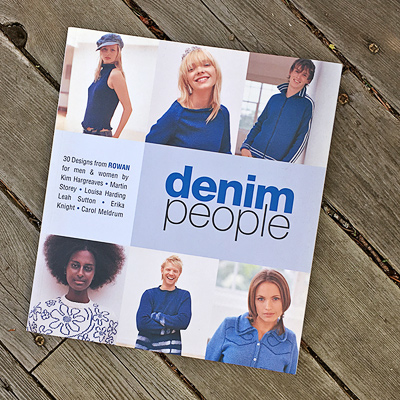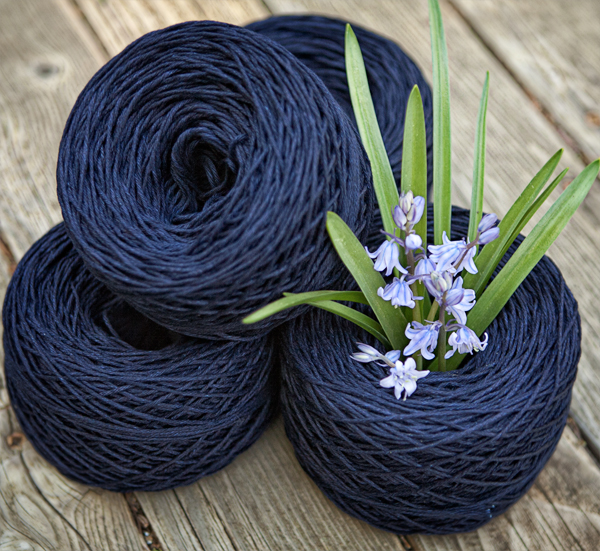Back in my early days, ooh, two decades out of the five ago I started knitting, I was entirely enthralled by a certain kind of yarn but much too SHY to actually make anything out of it.
Now, coming from someone who knit a whole sweater out of dishcloth cotton, that is, perhaps, a bold statement.
Instead, I lusted season-after-season after pattern designs that highlighted this gorgeous indigo yarn and procrastinated and procrastinated until this happened

which featured a rather freckly hunk you might know:

But even with all that inspiring, lustable goodness, and the fact that I WAS one of the Denim People (aren’t we all!) I only got as far as getting the yarn itself.
And I got a ton: 3 cones worth, dark navy, 2000 yds per cone – which is [pulls out trusty converter], hmm, 3.4 MILES of YARN, yes, you read that right.
Well, this week is The Week I now am going to go down That Road.
I found out, while sorting and saving the favorite yarns in my stash, I could not resist its dark navy siren call any longer and started winding off some skeins.

about That YARN
The yarn I purchased was called Den-M-Nit and although it wasn’t the branded the same as in the magazine, it was from the same original mill source.
Also common to both? An indigo dye process, just like the one used in the making of blue jeans, where the fiber itself is surface-dyed.
If you open up one its six plies, you can see their inner white cores.

The dye does not fully penetrate the strands – it is called ring dyeing – and it’s usually achieved through the rope dyeing process (cool industry-on-parade link here).
This allows the outer layer to fade away from blue-to-white in degrees through wear and washing, leaving a lovely tonal range of blue over the surface of the fabric, whether woven or knit.
The best kind of design for this variable fading fabric is something that has Highs & Lows.

Like cable patterns or knit/purl combinations, or in my case: Lace formed with yarnovers and decreases, like in my design CERISARA.

The decrease stitches are higher than their neighbors and, in the case of the CERISARA design, push the next rows stitches higher for awhile as well.
It’s almost like a series of small cables waving back and forth – beautiful.
That eyelet patterning is coupled with reverse Stockinette stitch, which has a high/low characteristic as well in its purl stitches and should subtly highlight the indigo fade.
MODS
The secret of success to using this yarn, which not only fades but SHRINKS in length (just like your favorite jeans) is to knit the garment you’re making LONGER. No compensation is needed for circumference/width.
• Gauge before Washing
20 sts / 28 rows
• Gauge after Washing
20 sts / 32 rows
The above is measured over 4″ but in terms of 1″ increments that’s:
7 rows vs 8 rows per inch
So, to scale my CERISARA design, I’m going to adjust:
• For every 1″ of original length / 1 extra row worked
Because this is a modular, organic design, which is defined by length proportions to begin with, this should be quite doable.
Now, to cast on (after I wash my hands after all that winding)…
…to be continued…
The Denim Saga
• [part 1] – About that Yarn
• [part 2] – The Sweater Awakens
• [part 3] – Knitting with Indigo Denim Yarn
• [part 4] – Picking Up Stitches using Denim Yarn
• [part 5] – Real-time Shrinkage in Denim Yarn
• [part 6] – the Final Rose – After Shrinking Denim Yarn


Oh I also loved this yarn, but didn’t even have the courage and probably cash to buy it. I am so looking forward to your blogs on this topic and to see the finished product. The pattern (your beautiful design) will look amazing. It will be so interesting to see how it wears/fades from washing and wearing. like jeans???? who knows.
Is the yarn still available to purchase, do you know???? just wondering..
have fun!
Can’t wait to see how this turns out! Also, it will be fun and interesting to see the modifications for the shrinking yarn — which I guess is “just” math ;-)
I have the exact same book, and also 3 cones of that same yarn (albeit 2 in the mid-blue and 1 in dark). I have had these for so many years, and still haven’t done anything with them. You are inspiring me to get started! Thank you!